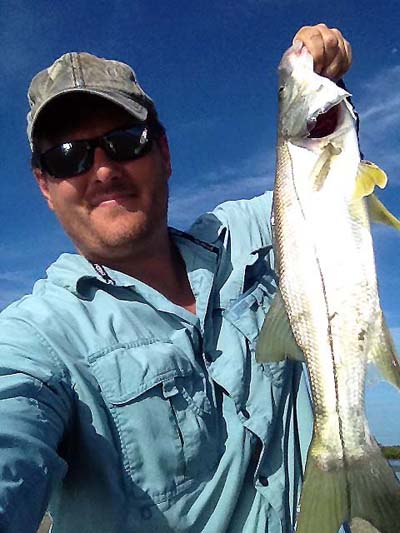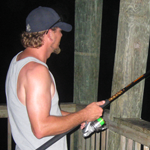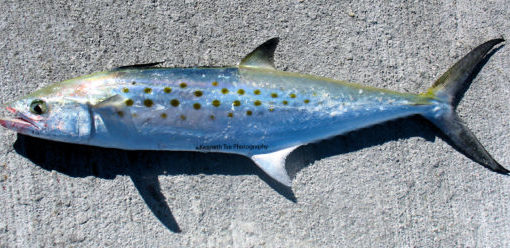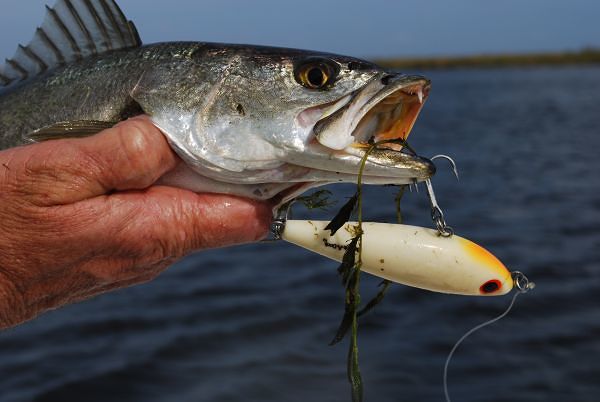The Common Snook (Centropomous undecimalis) is a member of the Snook Family that has 4 other species of Snook that are primary found around Florida. The Common Snook (referred to as Snook from here on) is by far the most frequently encountered, but all other Snook species are very similar in appearance, habitat and behavior.
The most prominent feature of a Snook is its vivid black stripe running the length of its body from tail to gill plate. Snook have a large, under-slung jaw that is attached to their rapidly tapering head. Their bodies are long and thick, giving them one of the highest weight to meat ratios of inshore fish.
Snook average from 3 to 15 pounds but larger fish up to 30 pounds are not rare. The world record is just above 53 pounds, but it is possible for Snook to reach over 60 pounds.
Equipment Needed
Snook are known as one of the best fighting inshore fish. They are fast, strong and can be quite heavy. Many Snook are caught near passes, bridges and other heavy cover, so gear that can handle that type of habitat is recommended.
Reels
The most popular and successful reel for catching Snook is a spinning reel. The reel should be saltwater rated and be able to handle monofiliment line up to 20 pound test or braid up to 35 pound test. The single most important features when selecting a reel for Snook fishing is a STRONG and SMOOTH drag. Snook make fast, hard runs that often time feature jumps. If the drag on the reel is not up to the task, more times than not the fight will end with broken line.
Where to Find Snook
Snook are found from Central Florida south and in most of the Gulf around Southern Texas. They are a tropical species that is most frequently found around mangrove shorelines, river mouths, passes flats, near bridges and piers, and around sand bars in the surf. Snook are not migratory, but they do travel a bit south when water temperatures begin to drop in areas around Central Florida.
The largest Snook are often caught in passes near inlets. Sebastian Inlet Florida is world famous for the large numbers of big Snook near the inlet, while Ft. Myers Florida and areas around the Everglades are famous of decent size fish that are found around mangrove shorelines that can be fished for by sight.
Bait and Lures for Snook
Snook are willing takers of many types of lures and many different types of live bait. They are very aggressive predators that will strke hard and fight hard.
Live Bait
A Snook’s primary diet consists of bait fish and shrimp. Here is a list of the most popular live baits for them:
- Croakers
- Pinfish
- Jumbo Shrimp
- Finger Mullet
- Majora
Lures
A lure that mimics any of the Snook’s natural prey will be successful. Some of the most popular lures for Snook are:
- “Walk-The-Dog” style top water lures
- Buck tail jigs
- Curl Tails
- Soft Plastic Jerk Baits
- Soft Plastic Imitation Shrimp
Techniques
Top Water
Early in the morning, just after sunrise, or late in the evening, just before sun set, Snook can be frequently caught on top water lures. A “walk-the-dog” style lure or a popping type lure work very well. Throw the lure beyond an area that Snook should be hanging out and work the lure through the strike zone. Snook will hit rather aggressively, but do not set the hook until pressure is felt from the fish. A hook set to early can pull the lure out of the strike zone is the fish misses its target.
Mangrove Shore Lines and Other Heavy Cover Areas
The most effective method of catching Snook in heavy cover areas is to pitch a live bait or lure into areas known to hold fish. Allow the live bait to swim around the area for a while, and if using a lure work the area a few times before moving on. Once a Snook hits, it is important to pull them away from cover as quickly as possible because they are masters of fowling line on cover and breaking off.
Open Water
Cast the lure/bait beyond areas that may hold fish. If using live bait slowly work the bait back to the area where the fish are holding and allow it to swim in the area for a while. With lures fan cast the area a few times covering all suspected areas. If a Snook does not hit in the first 15-20 minutes move on to another spot, there may be better luck there.
Quick Tips
- Snook are heavily affected by tidal patterns. If visible fish are not hitting during the outgoing tide, they might during the incoming.
- Snook have a sensitive lateral line. Lures/baits that move a lot have a good chance of attracting a strike
- The gill plates on Snook are razor sharp. Be careful when handling them and don’t be discouraged if they cut the line, it happens to all anglers one time or another.
- If you are good at catching Large Mouth Bass, similar techniques can be quite successful with Snook.
Related Articles





